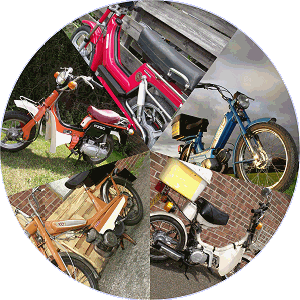In the 1970s we remember when you used to be able to pick up old mopeds for next to nothing, but what with inflation and old mopeds lately becoming retro collectibles, it doesn’t seem so easy to do that any more.
So the question is: what might you get within £50 today?
Unless you happen to be very lucky, it’s not likely to be anything good that’s ready to ride, and you’ll almost certainly need to be prepared to do a bit (or possibly a lot) of work to whatever, to get it to go … so these are what our local workshops managed to buy in…
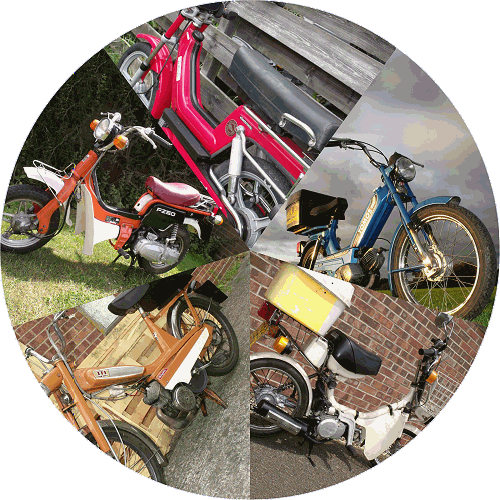
Introduced to the UK in April 1979, our 1980 Suzuki FZ50 is one of the early FZ models, which initially came with a contact magneto set; later ones were changed to electronic ignition. Though all FZs look the same, there were a lot of twiddly changes between the early contact models and the later electronic models, so a number of parts are not so readily transferred between the FZ generations.
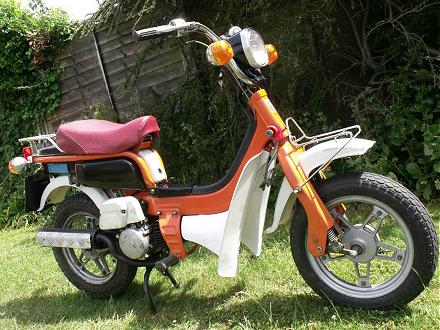 This bike technically
came ‘free’ as part of a job lot of four Suzuki FZ50s
for £100 that were processed by the workshops. The
first two FZs that were built up seemed better and more
complete. The third complete bike was a shortened
‘cut-&-shut’ track bike that was broken up for
parts. This fourth bike came as literally no more than an
engine in a bare frame with a number plate, and a large pile of
completely dismantled parts, so a lot of sorting out and building
up was required. The engine top-end, magneto set and
carburetter were serviced, and the oil changed in the primary
case. The forks were built up with suspension parts and
head bearings from the track bike. Wiring was made up from
the best bits of two harnesses, the rotted seat base welded up
and re-covered. The broken mudguards were plastic welded
back together. Exhaust reconditioned and a Dural
chequer-plate heat shield made for effect. Most of the
cycle fittings were variously picked from sifting through the
selection of bits, and when the final score was tallied, the
rebuild costs came to just £4.50p for a speedo cable,
£2.50p for two bulbs, and £6 for a new battery.
It’s original registration was traceable from the number
plate, then £25 for a replacement V5c from DVLA on a V62
application—total accounted cost £38, but the amount
of time that went into rebuilding the bike probably
wouldn’t have been considered at all commercially viable
for what the end result was actually worth.
This bike technically
came ‘free’ as part of a job lot of four Suzuki FZ50s
for £100 that were processed by the workshops. The
first two FZs that were built up seemed better and more
complete. The third complete bike was a shortened
‘cut-&-shut’ track bike that was broken up for
parts. This fourth bike came as literally no more than an
engine in a bare frame with a number plate, and a large pile of
completely dismantled parts, so a lot of sorting out and building
up was required. The engine top-end, magneto set and
carburetter were serviced, and the oil changed in the primary
case. The forks were built up with suspension parts and
head bearings from the track bike. Wiring was made up from
the best bits of two harnesses, the rotted seat base welded up
and re-covered. The broken mudguards were plastic welded
back together. Exhaust reconditioned and a Dural
chequer-plate heat shield made for effect. Most of the
cycle fittings were variously picked from sifting through the
selection of bits, and when the final score was tallied, the
rebuild costs came to just £4.50p for a speedo cable,
£2.50p for two bulbs, and £6 for a new battery.
It’s original registration was traceable from the number
plate, then £25 for a replacement V5c from DVLA on a V62
application—total accounted cost £38, but the amount
of time that went into rebuilding the bike probably
wouldn’t have been considered at all commercially viable
for what the end result was actually worth.
Anyway, it’s a back-from-the-dead 35-year-old Suzuki moped which, as a typical 16er machine from the ’80s, nobody would probably have expected it to see out the decade.
We’ve already covered the Suzuki FZ50 in the earlier Evolution article, with little point in repeating that history, so getting straight into our road test…
The kick-start mechanism is only engaged by pulling in the back brake lever, otherwise it feels as though something is missing inside the engine, and the starter lever just goes freely down and back up again on the return spring. The two-speed auto-transmission makes the FZ a little more interesting to ride than straight auto or CVT machines, as first stage gear takes the bike up to 15mph, where the mechanical auto-trans switches up to second stage and the revs drop as the high ratio engages.
From all three FZs that the workshops completed, this was unanimously voted the best performer, with buzzy but smooth acceleration and readily clocking a healthy 34mph on a light downhill run.
Everything on the bike worked really well, all electrics, brakes, handling and road holding were all good—a great little bike re-assembled from a total basket case.
 Our 1989 Yamaha QT50
was taken in by the workshops in lieu of a £50 debt, so
does that qualify? We think it does, so makes the cut into
our 50-quid feature, though subsequently cost a little more on
top to return to a suitable standard. The bike was mostly
complete, with a number of small parts and other spares in the
back-box. It came with V5c docs, and had reportedly run,
but the main bearings were very noisy.
Our 1989 Yamaha QT50
was taken in by the workshops in lieu of a £50 debt, so
does that qualify? We think it does, so makes the cut into
our 50-quid feature, though subsequently cost a little more on
top to return to a suitable standard. The bike was mostly
complete, with a number of small parts and other spares in the
back-box. It came with V5c docs, and had reportedly run,
but the main bearings were very noisy.
The motor was stripped, with main bearings and crank seals replaced, but the cylinder bore and piston also proved in dire condition, requiring an oversize piston set, rebore and hone, which pushed the cost of the essential engine repairs above the initial cost of the bike.
Since the motor was freshly re-bored and not yet run-in, it wasn’t so practical for us to do our usual full-circuit road test, pushing the bike as hard as we could through various conditions over a 6-mile course, but we’ve comprehensively covered a QT50 test before in Shop till you Drop. It’s just a case of seeing if we think this one goes much the same in a brief run…
Pulling off from a standstill and, once the automatic clutch has engaged, the QT is relatively sluggish as it struggles against its single-speed drive ratio. Around 15mph the revs have got up enough for the motor to be climbing into the power band, and with the reed-valve induction, the bike really picks up acceleration and readily takes the needle off the end of the 30mph speedo before we’ve even got to the end of the road!
Steady on Yamaha, there’s a corner coming up, so there’s a moment of pulling on the brakes really hard to drag the speed back down again, wallow and bounce into the corner as the basic commuter/shopper handling proves every bit as bad as it looks. Round the corner, power back on, and QT is off again like a startled mountain goat! With the wire basket quivering away up front it’s like a Tesco shopping trolley gone berserk! Great engine, inadequate brakes, and diabolical handling—that’s surely a crash combination looking for somewhere to happen?
Just running along the following short straight to the main road, the speedo needle was again easily off the 30 dial into uncharted territory that we guess would have been somewhere around 34–35mph if there had been any numbers there. Speed was still building up, but this motor hasn’t run in yet, so we really need to ease back in the interests of engine preservation. Seems like we’ve established that it goes well enough anyway.
The Yamaha QT50 had a quality-engineered 50cc reed-valve induction engine complete with shaft drive, though was slightly handicapped on initial getaway by its single-speed automatic transmission. A bullet-proof and well performing motor, but what a miserable and disappointing cycle chassis to have put it in!
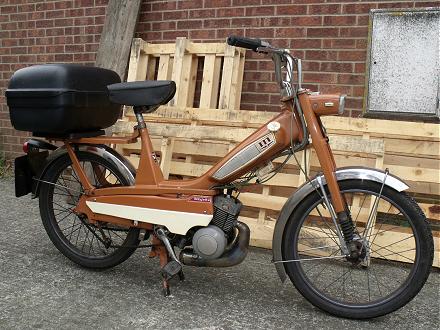 Mobylette N40T—not one from our workshops, but
this bike was bought in by Chris ‘Moped Doctor’ Day
for £50. There were several issues, but no doubt
about it: that was a real bargain!
Mobylette N40T—not one from our workshops, but
this bike was bought in by Chris ‘Moped Doctor’ Day
for £50. There were several issues, but no doubt
about it: that was a real bargain!
The throttle jammed, performance was poor, and the engine cut out when it got hot—so you then had to wait by the roadside until it cooled down so the spark returned. This is a classic Mobylette complaint, and often cured by throwing the old Novi capacitor as hard as you can into the scrap bin, then fitting a good quality ignition capacitor of a different make.
The jamming twistgrip was a worn out throttle cursor (again a common Mobylette complaint), which also failed to open the throttle slide wide in the carburetter—so a new cursor and cable inner wire, then performance and reliability seems to be fully restored. It really can sometimes be that simple!
The N40T was a popular and basic low cost 1970s’ Moby model, with a rigid rear frame, single saddle, non-vario single-speed drive, and a tiny 70mm front hub brake.
Chris has run the bike around a bit to settle it in, and reports it goes pretty well now, so we give it a spin.
As far as we know, this is a completely stock Moby40 model with AR12 Gurtner carb, original 8:1 compression, and running standard gearing.
We run it round the test course against a head wind to work some heat into the motor (they go better when they’re hot), then turn around for a tailwind return.
Best on flat with a tailwind in crouch position indicated 42 / pace 35 (Huret speedos often give optimistic readings).
Downhill run with tailwind in crouch position indicated 48 / pace 38.
There was a fair bit of ‘active vibration’ to report above 35 on the clock, but overall, the bike went very well and certainly represented great value for money.
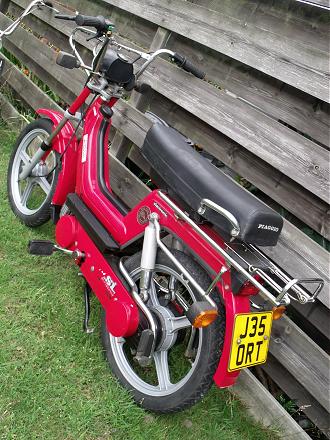 Piaggio Vespa Si 1992—the first thing
you’re probably going to be wondering is how on earth could
the workshops be picking up such a smart looking, modern
(it’s only 23 years old!), and low-mileage bike (less than
5,000km) for 50 quid?
Piaggio Vespa Si 1992—the first thing
you’re probably going to be wondering is how on earth could
the workshops be picking up such a smart looking, modern
(it’s only 23 years old!), and low-mileage bike (less than
5,000km) for 50 quid?
Well it certainly didn’t look like this when it came in, having stood out as a total derelict in all weather at the bottom of a garden for two years, and there was quite a serious issue with the bike, which is why it had been abandoned in the first place—there was no spark, and the Si is electronic ignition, so that’s a pretty significant problem.
There are basically two components in a Si electronic ignition, a CDI/HT unit beneath the fuel tank, and a generator set on the motor which needs the engine removed to access, and demands a special extractor to remove the magneto flywheel.
Removing the flywheel exposes three lighting generator coils, one ignition generator coil and a pulse generator coil, all with very rusty poles (which can ‘upset’ ignition reading), so they’re all cleaned off and re-lacquered, then we continuity test all coils and leads. All OK there, refit the flywheel, connect the CDI, and bench test by turning the motor with a drill. Still no spark, so it’s got to be the CDI/HT unit.
A new CDI/HT unit for one of these cost us just £23 including postage from SIP Scootershop in Germany; it arrives in three days, plug it in for bench test again—and now it sparks fine.
Return the motor to the frame, weld up the rusty exhaust pipe (which had cracked when being removed), reassemble the CVT transmission, a major clean-up and re-commissioning, and we’re back in business.
The Si is a sort of longer frame built-for-two version of the Ciao moped with dual seat and rear footrests! It has a proper telescopic fork set up front, and twin-shock rear suspension at the back, with chunky 2.50 × 18 tyres on cast alloy wheels.
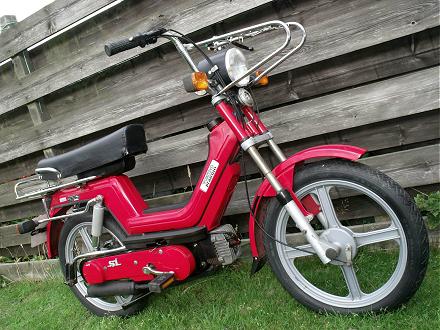 Despite a late dating of 1992, it’s still a
proper old-style moped with pedals. While many mopeds
became restricted ‘slopeds’ with footrests and
kick-starting after the infamous re-specification of 1st August
1977, the Si seemed to have defied evolution. Piaggio Vespa
Si’s were only listed in the UK from April 1981 to October 1982, so
they not a model commonly found in Britain. Our example was
a Spanish market imported bike, so we suspect it may be even more
performance limited than a UK
market restricted ‘Slo-ped’.
Despite a late dating of 1992, it’s still a
proper old-style moped with pedals. While many mopeds
became restricted ‘slopeds’ with footrests and
kick-starting after the infamous re-specification of 1st August
1977, the Si seemed to have defied evolution. Piaggio Vespa
Si’s were only listed in the UK from April 1981 to October 1982, so
they not a model commonly found in Britain. Our example was
a Spanish market imported bike, so we suspect it may be even more
performance limited than a UK
market restricted ‘Slo-ped’.
Being a derivative of the original Ciao engine, the motor dates back to the mid-1960s, so Piaggio certainly got their money’s worth out of this horizontal design. The engine has a cylinder barrel made of cast iron, but you can see hardly anything of that since it’s pretty much covered with fan-cooling shrouds, while the cylinder head is cast aluminium and sits beyond the shrouds, so is naturally cooled by airflow.
Fuel is still the old-fashioned pre-mix indicated at 2% / 50:1, while generally most two-stroke bikes of this time had long moved over to Pozi-force lubrication systems—another indication that the Si is a bit of a throwback.
There’s a fuel tap tucked beneath the right-hand footplate off–on–res, and pull an adjacent choke rod to engage the strangler, which will automatically snap-release when the throttle is fully opened.
Starting the Si is much better effected on the stand (rather than trying to pedal it up the road—more about that later). Pull in the decompresser trigger under the left handlebar, press a pedal down firmly so the starter clutch engages to spin the motor, release the decomp and she fires up. Leave to stew on the choke for a minute, and then open the throttle wide to release the strangler. A couple of blips on the throttle, nudge off the stand, and we’re ready to go.
The CVT drive works very effectively for initial acceleration, giving a strong torquey pull for a smart getaway, and gives a convincing impression that it really could pull a passenger quite effectively too.
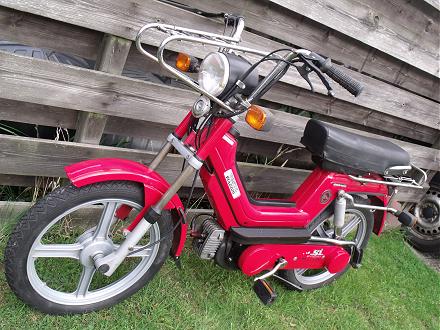 The
variator range though, seems to be rather a short spectrum, and
quickly runs out, so engine revs start increasing beyond 25 on
the speedo. That might appear pretty good for a moped, but
this bike has a 60km/h
CEV speedometer, so 25km/h is just 15mph, and there’s already some
appreciation that the Si may not be so sprightly at top end
performance.
The
variator range though, seems to be rather a short spectrum, and
quickly runs out, so engine revs start increasing beyond 25 on
the speedo. That might appear pretty good for a moped, but
this bike has a 60km/h
CEV speedometer, so 25km/h is just 15mph, and there’s already some
appreciation that the Si may not be so sprightly at top end
performance.
Effective exhaust silencing muffles the engine tone to nothing more than a steady hum, which only rises in pitch as the revs increase. Once the motor worked some heat into its metal, the bike would generally cruise along the flat at full throttle around an indicated 35–40km/h (paced 25–26mph), dropping back a little against inclines, but still pulling uphill confidently enough not to require any pedal assistance.
Tucked into a crouch, our downhill run managed to creep past the 45km/h marker, maybe indicated 47, which our pacer confirmed as a best of 29mph, at which speed you could hear the engine transfer porting starting to break down into four-stroke phasing, so that pretty much seemed to be the bike’s ceiling—no, try as we might, it just wouldn’t do 30mph.
We think this Spanish market model was probably limited to 45km/h, and much of the performance restriction is reportedly within the rotary induction valve, which is part of the crankshaft, so not readily resolved.
Both brakes were good, the telescopic forks ride well up front, though suspension seemed a little bouncy on the rear shocks, and we’d probably expected something firmer at the back-end considering the bike is designed as a two-seater. Overall, handling was good, though a low level of vibration did start coming through as the revs worked up.
While the performance within its range made the bike effective enough for general town use, overall the Si was a pretty miserable machine to use. The toneless silencer and CVT made it a thoroughly monotonous ride, while its restricted speed found the bike floundering on main roads and something of an irritation to impatient motorists who will always be backed-up behind the Si’s lack of performance.
The 12V battery-less rectified DC lighting system was very effective, with a nice bright headlight (though just off–on continental style single filament and no beam–dip), good raspy 12V DC horn, and efficient blinking indicators.
If you want to disengage the motor and switch over to pedal drive, just push in a hidden black button through the back of the left-hand side panel. This disables the reduction box at the rear hub, so pedalling like a bicycle is light and easy with no drag from the transmission. Then there’s the puzzle of trying to figure out how to re-engage the drive? There’s a small hidden lever down behind the panel to release the button and re-engage the hub.
General fittings are well appointed, a telescopic sprung rear carrier extends by 4½" if you can figure out how to release a latch tucked away under the back of the saddle. There are also spring-loaded parcel clips on both the rear and front handlebar carriers.
The seat is further fitted with a couple of handles each side at the back, though these are more probably intended as something for a pillion rider to hold on to, rather than for lifting the bike onto the stand, since if you try loading onto the stand with the handles, then you feel the side of the seat base disconcertingly flexing and bending—you don’t want to be using those handles for that!
There’s also another hidden lever underneath the right-hand side of the saddle (Piaggio sure liked their secret latches—it’s like Indiana Jones), which releases the seat to hinge over and reveal a couple of small tool trays.
The centre stand is a most dreadful contraption. It’s not only difficult to haul onto the stand, but it’s also one of those horrible spring-back-up-on-its-own devices, with a strong spring, so the whole action of putting the bike on the stand is like a professional wrestling match. You quickly get to hate that stand.
Now while we’re on the subject of horrible … back to starting the bike … easiest on the stand, but you won’t try actually pedal starting one of these many times.
Si pedals off like a bicycle, then the starter clutch shoes kick-in with a bang, and nearly throw you over the handlebars! What’s going on here is the CVT is in low ratio drive, so you’re suddenly trying to turn the motor over with the ratio working against you—which is almost like hitting a wall! Using the decompresser doesn’t help at all, so after a couple of painful attempts at this … you won’t try that again.
It’s no better trying to pedal-start with the bike on the stand either, same problem and more tears.
Basically it’s down to kick-starting the bike on the stand, but if the stand ‘settles’ so the back wheel drags the ground, that could become increasingly difficult…
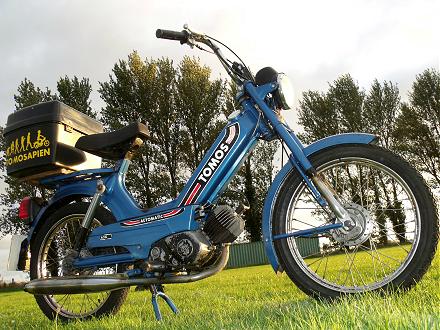 Our selection of
50-quid delights continues with a blue Tomos A3 two-speed auto
model dated to 1984.
Our selection of
50-quid delights continues with a blue Tomos A3 two-speed auto
model dated to 1984.
Again, not one of our workshop bikes, but another steed from the stable of Chris ‘Moped Doctor’ Day, bought in as a derelict wreck for £25, then rebuilt on the tightest economy budget for use as a workshop ‘hack’ bike, since which it has covered over 14,000 miles, and reportedly is still going strong (in between further economy-budget rebuilds).
Earlier Tomos engines were initially designed as pedal mopeds, then subsequently adapted to kick-start and footrest equipped ‘sloped’ specification as the regulations changed, but obvious witness where the old pedal shaft went through still remains on the A3 motor to indicate its history.
The Tomos A3 motor is an evolutionary offshoot from the Tomos company’s earlier days of licence factoring Puch models. While the two-speed auto motor short-block was a Tomos design, its piston is the same as the Puch MS50 fan-cooled piston, and port mapping in the cylinder block is an identical match simply translated from the Puch configuration. This accounts for the old-style, over-square motor specification of 38mm bore × 43mm stroke iron cylinder. The cast alloy head is 8.5:1 compression ratio (much lower than the Puch 11:1), with a 12mm Encarwi carburettor rating the engine as 2bhp@5,500rpm.
We’ll probably not be expecting any sparkling performance since a ‘sloped’ plate on the frame indicates 30mph compliance, and gives weight at 45kg, which at least saves us from getting out the scales.
With spoked wheels on chrome plated rims and tyres sized 2.25 × 16, the Tomos maintains a ‘traditional moped’ look, and the cast alloy hubs present something of a quality touch in comparison to typical Italian market pressed tin equivalent hubs of the period.
The speedometer and headlamp are ‘joined’ at the headstock by a plastic moulding that makes it appear like a nacelle style assembly, which is easily adopted by the eye so that it may not be appreciated this is no more than a simple trim.
Fuel tap off–on–res tucked at bottom right of the frame fuel tank, just in front of the side panel.
The 12mm Encarwi carburettor choking function is rather unusual, thumb the black button on the throttle away from your hand, and turn the twistgrip forward to ‘extended’ range. The choke function will automatically disengage when you open the throttle again, and the twistgrip returns to normal range as the thumb button re-engages the choke latch.
The left-hand kick-start is quite unnatural and clumsy to operate while you’re sitting on the bike, so most riders are likely to dismount and stand on the left side of the bike, to kick with their right foot. A couple of jabs on the starter soon have the motor fired up and we leave the bike to run a little before blipping the throttle to clear the choke.
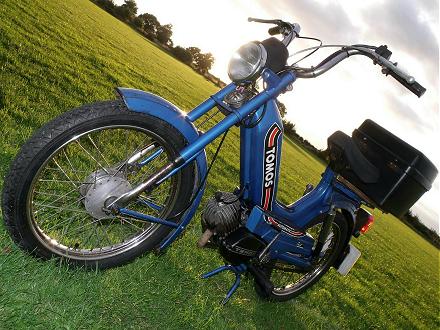 For pulling away,
there’s nothing to do except turn open the twistgrip and
lift your feet onto the footrests.
For pulling away,
there’s nothing to do except turn open the twistgrip and
lift your feet onto the footrests.
First gear range runs up to around 15mph, when the bike seems to hover on a plateau of revs for a few seconds while it hesitates … to think about the up change … will it … yes, alright … before lurching into second and surging forward again in top ratio. The Tomos two-speed automatic gear change is actually something that can add a little interest to the largely uneventful performance, since you can induce a timely and quicker up change by backing off the throttle at the crucial point as the revs peak out, so effectively skipping the ‘automatic plateau’ phase. Much the same can be effected on the down change for hill climbing if you find the revs bogging down with the auto locked in second under load, just momentarily back of throttle and it can similarly be ‘switched’ back down to first.
Early exchanges with our pace rider quickly established the 40mph Tomos CEV speedometer seemed to be reading accurately at lower speeds, but became progressively more optimistic beyond 25.
Best on flat in upright stance paced at 31mph (Tomos CEV speedo reading slightly fast, indicating 33).
Best on flat in crouch paced 33mph (speedo reading 36). Downhill run paced 37mph (reading past 40).
Uphill dropped back to actual 22 (reading 22), at which the speed hadn’t dropped enough to initiate any automatic change back down to first, so still managing to crest the rise in second. Even with a heavy rider, the low first ratio would probably be capable of getting the bike up pretty much any steep hill … but probably only slowly and steadily.
The kick-start engine seems to rev fairly smoothly, but you quickly become aware of a high frequency vibration tingling through the footrests, handlebars and seat. Also noticeable is a low level of un-definable mechanical noise from the motor, and there’s always a bit of a feeling that the quality of engineering inside might be slightly ‘loose’? It’s not that there’s anything particularly tired or wrong with this relatively high mileage example either—our Tomos aficionados tell us this ‘loose mechanical’ impression is quite typical and normal.
General handling and brakes were quite good, so the bike could be pushed along consistently to maintain a steady pace. The silencer note was fairly mellow with a definable subdued popping emanating at lower revs, and the exhaust tone was always moderate, discrete and pleasant, so wouldn’t attract undue attention—unless someone maybe took a hacksaw to the baffle…
The foam moulded saddle was reasonably comfortable, apart from the progressive intrusion of vibration if you’d been riding it on throttle for some time.
As you’d probably expect, there’s a number of proprietary fittings on the A3, with Magura controls, CEV 6V AC direct lighting set with brake light switching powered from an Iskra magneto flywheel generator (licensed Bosch copy), and CEV speedo set.
The Tomos A3 is generally a fairly bland and uneventful machine to ride, doing what it’s supposed to do in a somewhat crude and plodding manner, though with some personality in the ‘basic engineering’ of its former eastern-block style ‘value-for-money’ engine, and the way the 2-speed auto-gear can actually be manually changed by throttle control.
Representing one of the cheapest 30mph budget mopeds in its day, the Tomos A3 probably represented quite good value for money at the time.


